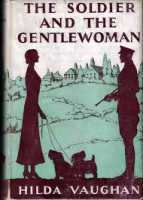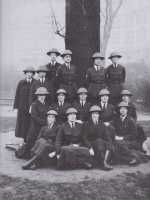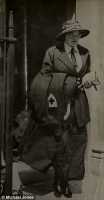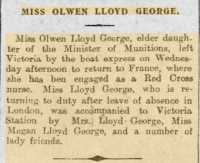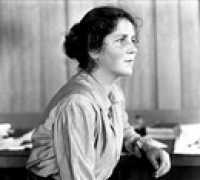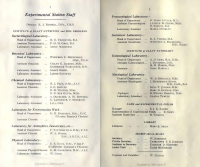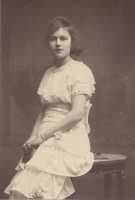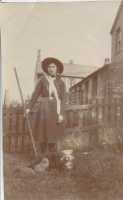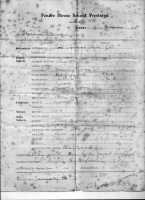Browse the collection
Sorted by date of death
Elisabeth De Saedeleer
Place of birth: Sint-Martens-Latem, Belgium
Service: Textile artist, painter
Death: 1972, Belgium, Cause not known
Notes: Elisabeth, born 1902, was the second of five daughters of the Belgian artist Valerius de Saedeleer. He was among a group of artists encouraged by Gwendoline and Margaret Davies [qv] to come to Wales as refugees in 1914. The family settled in Aberystwyth, with strong ties to University College, Aberystwyth. Elisabeth and her older sister Marie became interested in weaving and tapestries (encouraged by a meeting with William Morris’s daughter May); both taught in the newly formed Arts and Crafts department of the college, together with their father. On her return to Belgium in 1921 Elisabeth became noted as a designer and weaver of textiles and tapestries. She set up a workshop, besides writing several books on the craft and undertaking many public commissions.
Sources: https://digitalcommons.unl.edu/cgi/viewcontent.cgi?article=1177&context=tsaconf\r\nhttps://www.aber.ac.uk/en/media/departmental/informationservices/pdf/specialcollections/the-davies-family-and-belgian-refugee-artists-and-musicians-in-wales.pdf\r\nArt in Exile: Flanders, Wales and the First World War. 2002\r\n
Reference: WaW0331

Newspaper report
Report of an exhibition fundraising for a students’ union building, a memorial to the war dead of University College, Aberystwyth. Cambrian News 25th April 1919
Rosa Cliff Ward
Place of birth: India
Service: Girl Guide Leader, 1912 - 1943
Death: 1984, Corscombe, Dorset, Cause not known
Notes: Rosa was born in India in 1893. Her father was a Brigadier General. In 1912 she founded the first Girl Guides company in North Wales, in Denbigh. The first was in Carmarthen (1910). Although she still under 21 she was soon appointed County Commissioner for Denbighshire. Rosa Ward seems to have introduced camping to the Guides; what was probably the first camp in Wales was set up by her at Segrwyd in 1916, and by 1931 she was the Guide Commissioner for Camping. Between 1939 ad 1944 she was Chief Commissioner for Wales She died in 1984 aged 101.
Reference: WaW0413
Hilda Campbell Vaughan (Morgan)
Place of birth: Builth Wells
Service: Cook, agricultural organiser, novelist, VAD, WLA, 1915 - 1919
Death: 1985, Cause not known
Notes: Hilda Vaughan, born 1892, was the daughter of a solicitor prominent in Brecknockshire and Radnorshire. Early in the war she joined the VAD as a cook at the Red Cross hospital in Builth but in 1917 left ‘to take up Land work with a salary’. During the time that she worked as a VAD, she took the lead in organising a free library for the town; it opened in November 1915. Hilda was already involved in encouraging women on to the land, and farmers to accept them. Her new position was organising secretary of the WLA in Breconshire and Radnorshire. After the war Hilda moved to London, married the novelist Charles Morgan, and began to write herself. Her work was much influenced by her experiences of meeting women of all backgrounds in the WLA.
Sources: https://www.southwales.ac.uk/study/subjects/history/worldwarone/jayne-bowden/
Reference: WaW0383
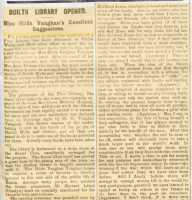
Newspaper report
First part of a report on the new Free Library in Builth. Brecon County Times 25th November 1915
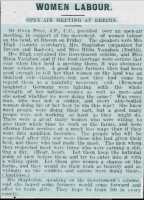
Newspaper report
Report of an open-air meeting in Brecon, publicising women and farm work. Brecon and Radnor Express 5th April 1917
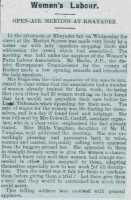
Newspaper report
Report of open-air meeting in Rhayadyr, commenting on Miss Vaughan’s ‘pleasing and persuasive …manner’. Brecon and Radnor Express 31st May 1917
Gabrielle (Bobby) West
Place of birth: Bournemouth
Service: Cook / Policewomen, VAD, 1916 - 1917
Death: 1990, Cause not known
Notes: Gabrielle (Bobby) West was the youngest of five children of a clergyman. Initially she volunteered as a VAD cook, but could not afford to continue to work unpaid, so began paid work at a munitions canteen in London. When police women began to be recruited to work in munitions factories she and her friend Miss Buckpitt joined. After a brief posting to Queensferry NEF they were promoted to Pembrey in January 1917. Her account of her time at Pembrey paints a very full picture of what life was like for the workers there. See her account of Mary Morgan [qv] and her fits. In May 1917 she was transferred to the Royal Ordnance factory, Rotherwas Hereford. When she was 89 years old Bobby was recorded for the Imperial War Museum’s oral archives.
Sources: ed Avalon Richards Menus Munitions and Keeping the Peace: The Home Front Diaries of Gabrielle West 1914 -1917. Pen&Sword 2016https://www.iwm.org.uk/collections/item/object/80008574
Reference: WaW0308

Pembrey
Gabrielle’s drawing of the danger buildings at Pembrey. ‘.. where the most dangerous work is done, the sheds are actually inside the hills.'
Olwen Elizabeth Lloyd George (Carey Evans)
Place of birth: Criccieth
Service: Volunteer, assistant cook, 1914 - 1916
Death: 1990, Cause not known
Notes: Olwen, second daughter of David Lloyd George, began volunteering in the Red Cross hospital near Criccieth in 1914 when she was 22. She then moved to London (where Lloyd George was Chancellor of the Exchequer, living at 11 Downing Street), and assisted her mother with the Welsh Troops Comfort Fund. In May 1915 she volunteered as an orderly at Rest Stations in Boulogne and later Hesdigneul. She later wrote ‘I was what they called a cooklet and I also used to scrub the platform. I used to say to my friends: “If you see a patch which is cleaner than all the rest, that’s my bit.” I worked so hard on it that I really believe you could have eaten off the floor!’ After her return to London and her marriage to Captain Tom Carey Evans, as her Red Cross Card says, she was not able to work! There is a short Pathé news film of her wedding at the Welsh Baptist Chapel in Westminster, with crowds of onlookers.
Sources: https://www.youtube.com/watch?v=lze8jeBJKOo
Reference: WaW0430
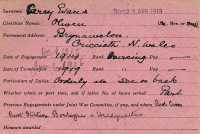
Red Cross record card
Red Cross card for Olwen Lloyd George. The dates of her service have been altered in pencil.
![Red Cross record card [reverse] Reverse of Olwen Lloyd George’s record card giving details of her service.](lluniau/1415464454719_image_galleryimage_careyevansolwen4_jpg_bawd.jpg)
Red Cross record card [reverse]
Reverse of Olwen Lloyd George’s record card giving details of her service.

Newspaper report
Report of Olwen Lloyd George’s marriage to Capt Tom Carey Edwards. Herald of Wales 23rd June 1917.
Mary Dilys Glynne (born Glynne Jones)
Place of birth: Upper Bangor
Service: Scientist, plant pathologist, mountaineer, Rothamsted Institute, 1917 - 1960
Death: 1991, Cause not known
Notes: Mary, born 1895, graduated from the botany department of University College Bangor in 1916 (in the same year as Mary Sutherland qv, and fellow Rothamsted worker Violet Gale Jackson qv). On graduating she briefly joined the Agriculture department at Bangor, but in 1917 moved to the Plant Pathology Department at the Rothamsted Experimental Station in Hertfordshire. In 1917 she was one of the founding members of the new Mycology Department there, working on crop diseases. She remained working at Rothamsted until 1960. Mary was also a renowned mountaineer, achieving many firsts for women during the 1920s and 30s.
Sources: Oxford Dictionary of National Biography
Reference: WaW0315

Newspaper report
Report of Bangor graduates including Mary Dilys Glynne, Violet Jackson and Mary Sutherland. North Wales Chronicle 7th July 1916.
Emma May Inker (Stevens)
Place of birth: Penarth
Service: Cook, WAAC / WRAF, 1918/03/15 – 1918/12/31
Death: 1992, Cause not known
Notes: Emma, born 2nd May 1894, worked as a seamstress and in service before joining the WAAC in March 1918. Shortly afterwards she was transferred to the WRAF on its formation on 1st April 1918. She was discharged on compassionate grounds on 31st December as her father was ill. Her daughter Rita Spinola says ‘She never talked much about her time in WW1 as a cook, but she did mention that once whilst marching in London someone shouted out to her “you’re out of step!”.’
Reference: WaW0267
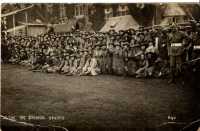
RAF Brigade sports
WRAFs at the RAF Brigade sports. Emma Inker can just be seen in the second row between the 6th and 7th people sitting on the ground. Thanks to Rita Spinola.
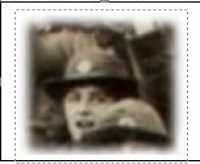
Emma May Inker
Close-up of Emma May Inker WRAF at the RAF Brigade Sports 1918. Thanks to Rita Spinola.
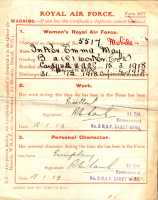
WRAF Discharge Certificate
WRAF discharge paper for Emma Inker on ‘compassionate grounds’. This shows her transfer from WAAC to WRAF.
Helen Smith (Thomas)
Place of birth: Swansea
Service: Child
Death: 1993, Swansea, Cause not known
Notes: Helen Smith, born 1908, was the daughter of Alfred and Elizabeth Smith of Swansea who emigrated to America when Helen was a few months old. In 1915 they decided to return to Swansea, and sailed on the Lusitania. When the ship was torpedoed on 7th May 1915 Helen had become separated from her parents and baby brother Hubert. They died, but she was rescued by a Canadian journalist, Ernest Cowper. She was reunited with her aunt Cecelia Owens, another passenger who had lost her two sons in the sinking. She later married John Henry Thomas and lived the rest of her life in Swansea.
Sources: http://www.rmslusitania.info/people/second-cabin/helen-smith/
Reference: WaW0227
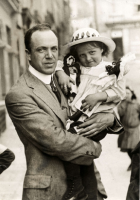
Helen Smith
Helen Smith with her rescuer Ernest Cowper. Photograph taken in Queenstown, County Cork, Ireland. Helen is wearing new clothes donated by local well-wishers.

Newspaper report (1)
Report of the story of Lusitania survivor Helen Smith (1). Cambrian Daily Leader 10 May 1915
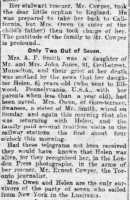
Newspaper report (2)
Report of the story of Lusitania survivor Helen Smith (2). Cambrian Daily Leader 10 May 1915
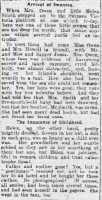
Newspaper report (3)
Report of the story of Lusitania survivor Helen Smith (3). Cambrian Daily Leader 10 May 1915
Helene Geens (Smart)
Place of birth: Malines/Mechelen, Belgium
Service: schoolgirl
Death: 1994, Cause not known
Notes: Helene Geens was one of the first Belgian refugees to arrive Prestatyn in October 1914, with her parents, younger brother and two maiden aunts. Her parents and brother returned to Belgium in 1915, but she remained with the two aunts. She settled rapidly into life there, attending Pendre, a private girls’ school, where she seems to have excelled, and joined the Girl Guides. She returned to Belgium after the war. She met and married her English husband in Belgium in 1928; they settled in Leicestershire. Their daughter Diane provided much information and these photographs to The Belgian Refugees in Rhyl website.
Sources: https://refugeesinrhyl.wordpress.com/geens/
Reference: WaW0437
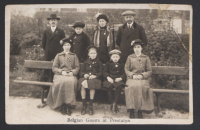
Photograph
rnrnThe Geen family in Prestatyn Helene and her brother Ivon are sitting between their two aunts.
May Selwood
Place of birth: Newport
Service: Wife, widow
Death: 1995-11-03, Cause not known
Notes: May’s husband William Henry Selwood died of shell shock on 1st January 1919. She remained a widow for her remaining 76 years – credited with being the longest WW1 widow in Britain. She is buried in Christchurch Cemetery, Newport.
Reference: WaW0106
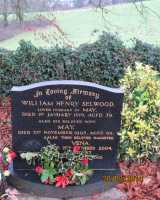
Grave of May Selwood
Grave of May Selwood who is credited with being the longest WW1 widow in Britain. Christchurch Cemetery, Newport

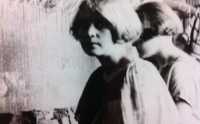
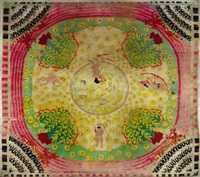
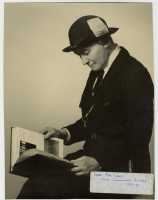

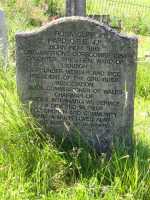
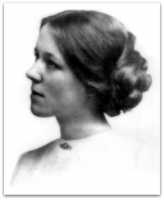
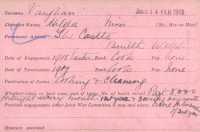
![Red Cross record card [reverse] Record of service of Hilda Vaughan [reverse]](lluniau/fb0698b4169ab6202b2e1de288cf4cd1_bawd.jpg)
